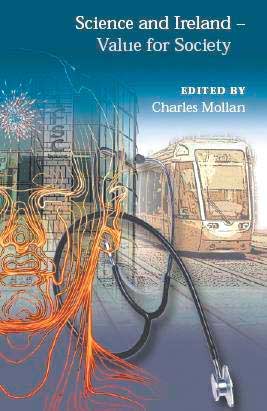| 2005 |

|
YEAR BOOK |
Book review
|
A review of Science and Ireland – Value for Society
|

The 2005 book is edited by Charles Mollan, the well-known author and editor of a variety of books on Irish science, both current and historical. It is published by the Royal Dublin Society, with the costs paid from a fund for the promotion of scientific activities set up by the family of Dr Arthur Hughes and his son-in-law Professor W.E.A. (Adrian) Phillips. The book is dedicated to the two men.
Arthur Hughes (1908-2000), who was born in London but spent most of his life in Ireland, is remembered by his children Rosamond Phillips, Caroline Roaf and Nick Hughes. Following a PhD in the Cavendish Laboratory, he joined Guinness in Dublin as a junior brewer in 1935. He had a long and successful career with the company, retiring as manager of the Dublin brewery in 1973. He was a strong supporter of the BA, serving as honorary secretary from 1965 to 1971.
Chris Stillman contributes the dedication to Adrian Phillips (1936-2003), a professor in the Geology Department of Trinity College, and founder of ERA and Maptec, two companies that have since amalgamated and are known to the public for their striking satellite images.
In keeping with tradition, the book gives information on the city in which the festival is taking place. Peter Pearson provides 16 pages on Dublin generally, not just its areas of scientific interest. The chapter is illustrated with several photographs of Dublin's buildings and objects.
Irish science is liberally interpreted as both science taking place in Ireland, whether by Irish or non-Irish researchers, and science carried out abroad by people born in Ireland, even if they left at a very early age. The foreword by Helen Haste, Professor of Psychology at the University of Bath, who chairs the BA Council and is a BA Executive Vice-President, sets the scene.
"Ireland is a country that has given the world a huge amount, partly because past economic constraints have led to extensive emigration and the dispersion of Irish talent throughout the world – to the great benefit of those who received it" is her generous comment.
The book provides a round up of facts and opinions about a range of scientific activities and policymaking. And although the theme is the value of Irish science to society, it also gives considerable historical context, so there is much here for history-lovers too. As well as his editorial foreword, Dr Mollan contributes a 58-page chapter on the history of Irish science, beginning with astronomical observations at Newgrange over five millennia ago, but concentrating on more recent centuries. His light touch brings the people concerned to life, including some who may not be familiar to all readers.
High-level commentators contribute a chapter each. Don Thornhill describes the development of a research culture. John Feehan looks at how Ireland treats its environment. Liam Downey and Gordon Purvis examine the building of a knowledge-based multifunctional agricultural and rural environment, a key issue in these days of steep decline in the number of full-time farmers. Still on the rural theme, Edward Farrell deals with forestry. And moving seawards, marine science is Christopher Moriarty's topic.
Dermot Kelleher describes past and future biomedical research in Ireland, and David McConnell covers genetics and biotechnology since 1950.
The backgrounds to two industrial sectors that contribute strongly to Irish exports are fleshed out. Matt Moran deals with chemical and pharmaceutical sciences, and Henry McLoughlin covers information and communications technology. Finally, Fionn Murtagh assesses Irish contributions to international science.
Throughout the book, the story of Irish science is told warts and all, taking in strategic deficiencies and the periods of financial neglect. The problems of doing science in a small country are noted, though it seems smallness may have its good points. Dermot Kelleher points out that an advantage of the relatively small size of the Irish research infrastructure is the enhanced potential for interdisciplinary research.
The book is beautifully presented, with high quality paper and print, and there is an extensive index. Science and Ireland – Value for Society should find a permanent place on the bookshelf of anyone interested in where Irish science has been and where it is going. Personally, I would have liked to have seen physics, microelectronics, and astronomy and space research given chapters, but the book is nonetheless an excellent benchmark of research in Ireland in 2005.
It is listed as Volume 2 in the Science and Irish Culture series (Why the History of Science Matters in Ireland, edited by David Attis and Charles Mollan, was the first). I can't wait for Volume 3.
Science and Ireland – Value for Society, edited by Charles Mollan. Hardback, xxx + 294 pages. Published by the Royal Dublin Society, Dublin, 2005, ISBN: 0 86027 050 5. It is available from Easons or direct from the RDS – [email protected] .
Anna Nolan ( [email protected] ) is a freelance science and technology journalist, writing for newspapers, magazines and websites. A past-president of the Irish Science & Technology Journalists' Association, she is its current national delegate to EUSJA, the European Union of Science Journalists' Associations.